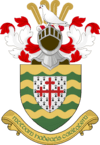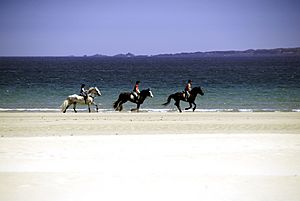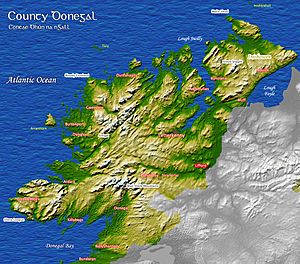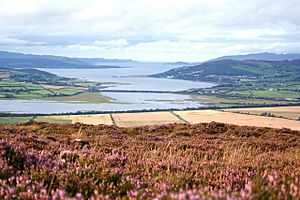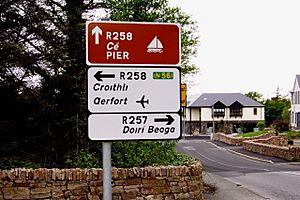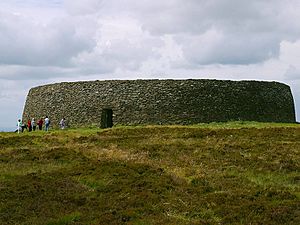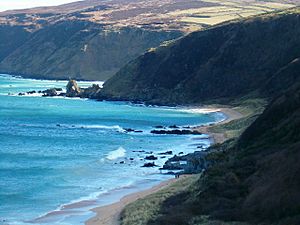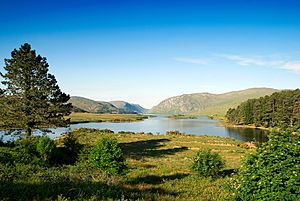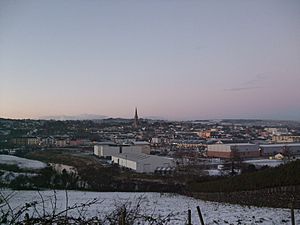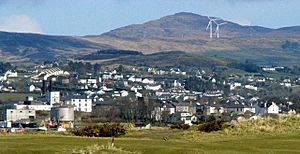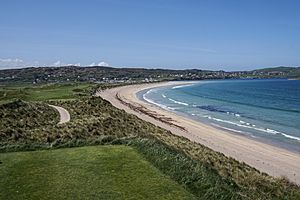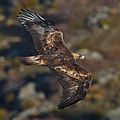County Donegal facts for kids
Quick facts for kids
County Donegal
Tyrconnell
Contae Dhún na nGall / Contae Thír Chonaill
Coontie Dunnygal / Coontie Dinnygal |
||
|---|---|---|
|
||
| Nickname(s):
The O'Donnell County, The Forgotten County
|
||
| Motto(s): | ||
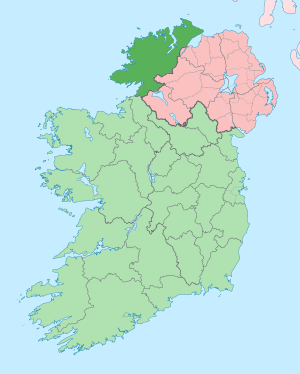
Location in Ireland, indicated in darker green
|
||
| Country | Ireland | |
| Province | Ulster | |
| Region | Northern and Western | |
| Established | 1585 | |
| County town | Lifford | |
| Largest settlement | Letterkenny | |
| Area | ||
| • Total | 4,860 km2 (1,880 sq mi) | |
| Area rank | 4th | |
| Highest elevation
(Errigal)
|
751 m (2,464 ft) | |
| Population
(2016)
|
159,192 | |
| • Rank | 13th | |
| • Density | 32.6/km2 (84/sq mi) | |
| Time zone | UTC±0 (WET) | |
| • Summer (DST) | UTC+1 (IST) | |
| Eircode routing keys |
F92, F93, F94
|
|
| Telephone area codes | 074 (primarily) | |
| Vehicle index mark code |
DL | |
| Coontie Dunnygal and Coontie Dinnygal are Ulster Scots spellings. | ||
County Donegal ( DUN-ig-AWL-,_-DON--; Irish: Contae Dhún na nGall) is a county of Ireland in the province of Ulster and in the Northern and Western Region. It is named after the town of Donegal (Dún na nGall, meaning 'fort of the foreigners') in the south of the county. It has also been known as County Tyrconnell (Tír Chonaill, meaning 'Land of Conall'), after the historic territory of the same name, on which it was based. Donegal County Council is the local council and Lifford the county town.
The population was 159,192 at the 2016 census.
Contents
Geography and political subdivisions
In terms of size and area, it is the largest county in Ulster and the fourth-largest county in all of Ireland. Uniquely, County Donegal shares a small border with only one other county in the Republic of Ireland – County Leitrim. The greater part of its land border is shared with three counties of Northern Ireland: County Londonderry, County Tyrone and County Fermanagh. This geographic isolation from the rest of the Republic has led to Donegal people maintaining a distinct cultural identity and has been used to market the county with the slogan "Up here it's different". While Lifford is the county town, Letterkenny is by far the largest town in the county with a population of 19,588. Letterkenny and the nearby city of Derry form the main economic axis of the northwest of Ireland. Indeed, what became the City of Derry was officially part of County Donegal up until 1610.
Baronies
There are eight historic baronies in the county:
- Banagh
- Boylagh
- Inishowen East
- Inishowen West
- Kilmacrennan
- Raphoe North
- Raphoe South
- Tirhugh
Informal districts
The county may be informally divided into a number of traditional districts. There are two Gaeltacht districts in the west: The Rosses (Irish: Na Rosa), centred on the town of Dungloe (Irish: An Clochán Liath), and Gweedore (Irish: Gaoth Dobhair). Another Gaeltacht district is located in the north-west: Cloughaneely (Irish: Cloich Chionnaola), centred on the town of Falcarragh (Irish: An Fál Carrach). The most northerly part of the island of Ireland is the location for three peninsulas of outstanding natural beauty: Inishowen, Fanad and Rosguill. The main population centre of Inishowen, Ireland's largest peninsula, is Buncrana. In the east of the county lies the Finn Valley (centred on Ballybofey). The Laggan district (not to be confused with the Lagan Valley in the south of County Antrim) is centred on the town of Raphoe.
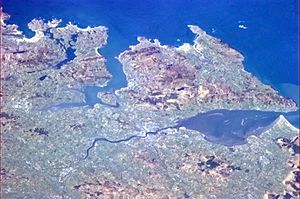
Demographics
| Historical population | ||
|---|---|---|
| Year | Pop. | ±% |
| 1600 | 7,889 | — |
| 1610 | 5,778 | −26.8% |
| 1659 | 12,001 | +107.7% |
| 1821 | 120,559 | +904.6% |
| 1831 | 141,845 | +17.7% |
| 1841 | 296,448 | +109.0% |
| 1851 | 255,158 | −13.9% |
| 1861 | 237,395 | −7.0% |
| 1871 | 218,334 | −8.0% |
| 1881 | 206,035 | −5.6% |
| 1891 | 185,635 | −9.9% |
| 1901 | 173,722 | −6.4% |
| 1911 | 168,537 | −3.0% |
| 1926 | 152,508 | −9.5% |
| 1936 | 142,310 | −6.7% |
| 1946 | 136,317 | −4.2% |
| 1951 | 131,530 | −3.5% |
| 1956 | 122,059 | −7.2% |
| 1961 | 113,842 | −6.7% |
| 1966 | 108,549 | −4.6% |
| 1971 | 108,344 | −0.2% |
| 1979 | 121,941 | +12.5% |
| 1981 | 125,112 | +2.6% |
| 1986 | 129,664 | +3.6% |
| 1991 | 128,117 | −1.2% |
| 1996 | 129,994 | +1.5% |
| 2002 | 137,575 | +5.8% |
| 2006 | 147,264 | +7.0% |
| 2011 | 161,137 | +9.4% |
| 2016 | 158,755 | −1.5% |
According to the 1841 Census, County Donegal had a population of 296,000 people. As a result of famine and emigration, the population had reduced by 41,000 by 1851 and further reduced by 18,000 by 1861. By the time of the 1951 Census the population was only 44% of what it had been in 1841. The 2006 Census, undertaken by the State's Central Statistics Office, had County Donegal's population standing at 147,264. According to the 2011 Census, the county's population had grown to 161,137.
Largest towns (2011 Census)
| Town | Population (2011 Census) |
|---|---|
| Letterkenny | 19,588 |
| Buncrana | 7,199 |
| Ballybofey/Stranorlar | 4,852 |
| Donegal Town | 2,607 |
| Carndonagh | 2,534 |
| Ballyshannon | 2,504 |
| Bundoran | 2,140 |
| Lifford | 1,658 |
| Bunbeg/Derrybeg | 1,553 |
| Milford | 1,530 |
| Moville | 1,481 |
| Convoy | 1,438 |
| Killybegs | 1,297 |
| Muff | 1,271 |
| Ramelton | 1,212 |
| Dungloe | 1,183 |
| Raphoe | 1,157 |
| Newtown Cunningham | 1,067 |
Physical geography
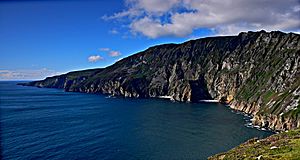
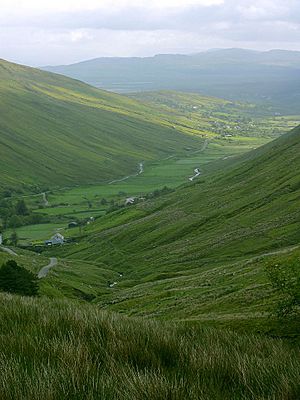
The county is the most mountainous in Ulster consisting chiefly of two ranges of low mountains; the Derryveagh Mountains in the north and the Blue Stack Mountains in the south, with Mount Errigal at 749 metres (2,457 ft) the highest peak. It has a deeply indented coastline forming natural sea loughs, of which both Lough Swilly and Lough Foyle are the most notable. The Slieve League cliffs are the sixth-highest sea cliffs in Europe, while Malin Head is the most northerly point on the island of Ireland.
The climate is temperate and dominated by the Gulf Stream, with warm, damp summers and mild wet winters. Two permanently inhabited islands, Arranmore and Tory Island, lie off the coast, along with a large number of islands with only transient inhabitants. Ireland's second longest river, the Erne, enters Donegal Bay near the town of Ballyshannon. The River Erne, along with other Donegal waterways, has been dammed to produce hydroelectric power. The River Foyle separates part of County Donegal from parts of both counties Londonderry and Tyrone.
Botany
A survey of the macroscopic marine algae of County Donegal was published in 2003. The survey was compiled using the algal records held in the herbaria of the following institutions: the Ulster Museum, Belfast; Trinity College, Dublin; NUI Galway, and the Natural History Museum, London. Records of flowering plants include Dactylorhiza purpurella (Stephenson and Stephenson) Soó.
Zoology
The animals included in the county include the European badger (Meles meles L.).
There are habitats for the rare corn crake in the county.
History
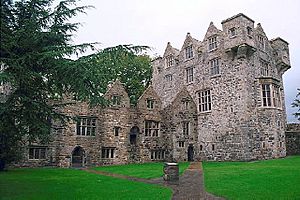

At various times in its history, it has been known as County Tirconaill, County Tirconnell or County Tyrconnell (Irish: Tír Chonaill). The former was used as its official name during 1922–1927. This is in reference to both the old túath of Tír Chonaill and the earldom that succeeded it.
County Donegal was the home of the once mighty Clann Dálaigh, whose most well-known branch were the Clann Ó Domhnaill, better known in English as the O'Donnell dynasty. Until around 1600, the O'Donnells were one of Ireland's richest and most powerful native Irish ruling families. Within Ulster, only the Uí Néill (known in English as the O'Neill Clan) of modern County Tyrone were more powerful. The O'Donnells were Ulster's second most powerful clan or ruling-family from the early 13th century through to the start of the 17th century. For several centuries the O'Donnells ruled Tír Chonaill, a Gaelic kingdom in West Ulster that covered almost all of modern County Donegal. The head of the O'Donnell family had the titles An Ó Domhnaill (meaning The O'Donnell in English) and Rí Thír Chonaill (meaning King of Tír Chonaill in English). Based at Donegal Castle in Dún na nGall (modern Donegal), the O'Donnell Kings of Tír Chonaill were traditionally inaugurated at Doon Rock near Kilmacrennan. O'Donnell royal or chiefly power was finally ended in what was then the newly created County Donegal in September 1607, following the Flight of the Earls from near Rathmullan. The modern County Arms of Donegal (dating from the early 1970s) was influenced by the design of the old O'Donnell royal arms. The County Arms is the official coat of arms of both County Donegal and Donegal County Council.
The modern County Donegal was shired by order of the English Crown in 1585. The English authorities at Dublin Castle formed the new county by amalgamating the old Kingdom of Tír Chonaill with the old Lordship of Inishowen. However, the English authorities were unable to establish control over Tír Chonaill and Inishowen until after the Battle of Kinsale in 1602. Full control over the new County Donegall was only achieved after the Flight of the Earls in September 1607. It was the centre of O'Doherty's Rebellion of 1608 with the key Battle of Kilmacrennan taking place there. The county was one of those 'planted' during the Plantation of Ulster from around 1610 onwards. What became the City of Derry was officially part of County Donegal up until 1610.
County Donegal was one of the worst affected parts of Ulster during the Great Famine of the late 1840s in Ireland. Vast swathes of the county were devastated by this catastrophe, many areas becoming permanently depopulated. Vast numbers of County Donegal's people emigrated at this time, chiefly through Foyle Port.
The Partition of Ireland in the early 1920s had a massive direct impact on County Donegal. Partition cut the county off, economically and administratively, from Derry, which had acted for centuries as the county's main port, transport hub and financial centre. Derry, together with west Tyrone, was henceforward in a new, different jurisdiction officially called Northern Ireland. Partition also meant that County Donegal was now almost entirely cut off from the rest of the jurisdiction in which it now found itself, the new dominion called the Irish Free State, which in April 1949 became the Republic of Ireland. Only a few miles of the county is physically connected by land to the rest of the Republic. The existence of a border cutting Donegal off from her natural hinterlands in Derry City and West Tyrone greatly exacerbated the economic difficulties of the county after partition. The county's economy is particularly susceptible, just like that of Derry City, to the currency fluctuations of the Euro against sterling.
Added to all this, in the late 20th century County Donegal was adversely affected by The Troubles in Northern Ireland. The county suffered several bombings and assassinations. In June 1987, Constable Samuel McClean, a Donegal man who was a serving member of the Royal Ulster Constabulary, was shot dead by the Provisional Irish Republican Army at his family home near Drumkeen. In May 1991, the prominent Sinn Féin politician Councillor Eddie Fullerton was assassinated by the Ulster Defence Association at his home in Buncrana. This added further to the economic and social difficulties of the county. However, the greater economic and administrative integration following the Good Friday Agreement of April 1998 has been of benefit to the county.
It has been labelled the 'forgotten county' by its own politicians, owing to the perception that it is ignored by the Government of Ireland, even in times of crisis.
Irish language
Much of the county is seen as being a bastion of Gaelic culture and the Irish language, the Donegal Gaeltacht (Irish-speaking area) being the second-largest in the country. The version of the Irish language spoken in County Donegal is Ulster Irish.
Of the Gaeltacht population of 24,744, 16% of the county's total, 17,132 say they can speak Irish. There are three Irish-speaking parishes: Gweedore, The Rosses and Cloughaneely. Other Irish-speaking areas include Gaeltacht an Láir: Glencolmcille, Fanad and Rosguill, the islands of Arranmore, Tory Island and Inishbofin. Gweedore is the largest Irish-speaking parish, with over 5,000 inhabitants. All schools in the region use Irish as the language of instruction. One of the constituent colleges of NUI Galway, Acadamh na hOllscolaíochta Gaeilge, is based in Gweedore.
There are 1005 students attending the five Gaelscoileanna and two Gaelcholáistí in the rest of the county. According to the 2006 Census, there are also 7,218 people who identify as being daily Irish speakers outside the Gaeltacht in the rest of the county.
Access
An extensive rail network used to exist throughout the county and was mainly operated by the County Donegal Railways Joint Committee and the Londonderry and Lough Swilly Railway Company (known as the L. & L.S.R. or the Lough Swilly Company for short). Unfortunately all these lines were laid to a 3-foot gauge where the connecting lines were all laid to the Irish standard gauge of 1,600 mm (5 ft 3 in). This meant that all goods had to be transhipped at Derry and Strabane. Like all narrow gauge railways this became a major handicap after World War 1 when road transport began to seriously erode the railways goods traffic.
By 1953 the Lough Swilly had closed its entire railway system and become a bus and road haulage concern. The County Donegal lasted until 1960 as it had largely dieselised its passenger trains by 1951. By the late 1950s major work was required to upgrade the track and the Irish Government was unwilling to supply the necessary funds, so 'the Wee Donegal', as it was affectionally known, was closed in 1960. The Great Northern Railway (Ireland) L.t.d. (the G.N.R.) also ran a line from Strabane through The Laggan, a district in the east of the county, along the River Foyle into Derry. However, the railway network within County Donegal was completely closed by 1960. Today, the closest railway station to the county is Waterside Station in the City of Derry, which is operated by Northern Ireland Railways (N.I.R.). Train services along the Belfast–Derry railway line run, via Coleraine railway station, to Belfast Central and Belfast Great Victoria Street railway stations.
County Donegal is served by both Donegal Airport, located at Carrickfinn in The Rosses in the west of the county, and by City of Derry Airport, located at Eglinton to the east. The nearest main international airport to the county is Belfast International Airport (popularly known as Aldergrove Airport), which is located to the east at Aldergrove, near Antrim Town, in County Antrim, 92 km (57 mi) from Derry City and 127 km (79 mi) from Letterkenny.
Culture
The variant of the Irish language spoken in Donegal shares many traits with Scottish Gaelic. The Irish spoken in the Donegal Gaeltacht (Irish-speaking area) is of the Ulster dialect, while Inishowen (parts of which only became English-speaking in the early 20th century) used the East Ulster dialect. Ulster Scots is often spoken in both the Finn Valley and The Laggan district of East Donegal. Donegal Irish has a strong influence on learnt Irish across Ulster.
Like other areas on the western seaboard of Ireland, Donegal has a distinctive fiddle tradition which is of world renown. Donegal is also well known for its songs which have, like the instrumental music, a distinctive sound. Donegal musical artists such as the bands Clannad, The Pattersons, and Altan and solo artist Enya, have had international success with traditional or traditional flavoured music. Donegal music has also influenced people not originally from the county including folk and pop singers Paul Brady and Phil Coulter. Singer Daniel O'Donnell has become a popular ambassador for the county. Popular music is also common, the county's most acclaimed rock artist being the Ballyshannon-born Rory Gallagher. Other acts to come out of Donegal include folk-rock band Goats Don't Shave, Eurovision contestant Mickey Joe Harte and indie rock group The Revs and in more recent years bands such as In Their Thousands and Mojo Gogo have featured on the front page of Hot Press magazine.

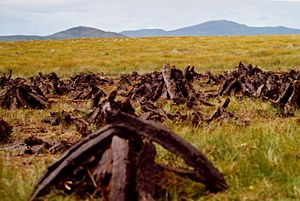
Donegal has a long literary tradition in both Irish and English. The Irish navvy-turned-novelist Patrick MacGill, author of many books about the experiences of Irish migrant itinerant labourers in Britain at around the start of the 20th century, such as The Rat Pit and the autobiographical Children of the Dead End, is from the Glenties area. There is a literary summer school in Glenties named in his honour. The novelist and socialist politician Peadar O'Donnell hailed from The Rosses in west Donegal. The poet William Allingham was also from Ballyshannon. Modern exponents include the Inishowen playwright and poet Frank McGuinness and the playwright Brian Friel. Many of Friel's plays are set in the fictional Donegal town of Ballybeg.
Authors in Donegal have been creating works, like the Annals of the Four Masters, in Irish and Latin since the Early Middle Ages. The Irish philosopher John Toland was born in Inishowen in 1670. He was thought of as the original freethinker by George Berkeley. Toland was also instrumental in the spread of freemasonry throughout Continental Europe. In modern Irish, Donegal has produced a number of (sometimes controversial), authors such as the brothers Séamus Ó Grianna and Seosamh Mac Grianna from The Rosses and the contemporary (and controversial) Irish-language poet Cathal Ó Searcaigh from Gortahork in Cloughaneely, and where he is known to locals as Gúrú na gCnoc "Guru of the Hills".
Donegal is known for the beauty of its textiles, whose unique woolen blends are made of short threads with tiny bits of color blended in for a heathered effect. Sometimes they are woven in a rustic herringbone format and other times in more of a box weave of varied colors. These weaves are known as donegal tweeds (with a small 'd') and are world renowned.
Although approximately 85% of its population is Roman Catholic,
The Earagail Arts Festival is held within the county each July.
People from Donegal have also contributed to culture elsewhere. Francis Alison was one of the founders of the College of Philadelphia, which would later become the University of Pennsylvania. Francis Makemie (originally from Ramelton) founded the Presbyterian Church in America. David Steele, from Upper Creevaugh, was a prominent Reformed Presbyterian, or Covenanter, minister who emigrated to the United States in 1824. Charles Inglis, who was the first Church of England bishop of the Diocese of Nova Scotia, was the third son of Archibald Inglis, the Rector in Glencolmcille.
Places of interest
County Donegal is a favoured destination for many travellers. The park is a 140 km² (about 35,000 acre) nature reserve with scenery of mountains, raised boglands, lakes and woodlands. At its heart is Glenveagh Castle, a late Victorian 'folly' that was originally built as a summer residence.
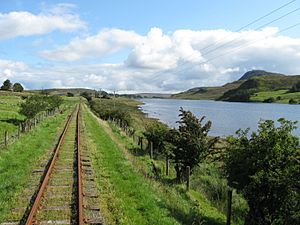
The Donegal Gaeltacht (Irish-speaking district) also attracts young people to County Donegal each year during the school summer holidays. The three-week-long summer Gaeltacht courses give young Irish people from other parts of the country a chance to learn the Irish language and traditional Irish cultural traditions that are still prevalent in parts of Donegal. The Donegal Gaeltacht has traditionally been a very popular destination each summer for young people from Northern Ireland. Scuba diving is also very popular with a club being located in Donegal Town.
People
A
- Adomnán - also known as Saint Eunan; Abbot of Iona 679–704.
- Francis Alison – prominent Presbyterian minister in the Thirteen Colonies and a leading member of the Synod of the Trinity. At least three of the signatories of the United States Declaration of Independence were former students of Alison, who was born and raised in the Parish of Leck, on the outskirts of Letterkenny.
- William Allingham – Victorian era poet from Ballyshannon.
- Altan – folk group.
- Ian Anderson – prominent Manx politician who was a long-serving member of the Tynwald. From Rathmullan.
- Kathleen Antonelli (née McNulty) – one of the original programmers of the ENIAC during World War II. Born in Creeslough and raised in Philadelphia.
- Sir Alexander Armstrong – Arctic explorer.
B
- General Sir Andrew Barnard – senior British Army commander particularly associated with the Napoleonic Wars. Born at Fahan in Inishowen.
- Bibi Baskin – former television presenter with RTÉ. Now a businesswoman and practitioner of Ayurveda in Kerala. Born and raised in Ardara.
- Neil Blaney – formerly a long-serving TD for the county and a former minister in the Irish Government. Founder of Independent Fianna Fáil.
- Oliver Bond (died in 1796) – a possible St Johnston native who was a Dublin-based member of the Society of United Irishmen.
- Packie Bonner – former goalkeeper for both the Republic of Ireland national football team and Celtic F.C..
- Ed Boyce – former trade unionist and former radical socialist in Idaho and Montana who later became a wealthy businessman. Helped form the Western Federation of Miners (WFM) in 1893.
- Denis Bradley - Derry-based journalist and political commentator who formerly served as the first Vice-Chairman of the Northern Ireland Policing Board from November 2001 until March 2006. He was also the Co-Chairman of the Belfast-based Consultative Group on the Past. Formerly a Catholic priest, he was born and raised in Buncrana.
- Stopford Brooke – Anglican and, later, Unitarian clergyman and literary historian. He served as chaplain to The Crown Princess Friedrich of Prussia, 1863–1865, and later served as chaplain-in-ordinary to her mother, Queen Victoria, 1875–1880. Was born and raised in Glendowan, just west of Letterkenny.
- Isaac Butt – barrister, Member of Parliament and founder of the Home Rule movement. Born and raised in Glenfin, a district near Ballybofey.
C
- William C. Campbell - winner of 2015 Nobel Prize in Physiology or Medicine, born in Ramelton.
- Clannad – folk group from Gweedore.
- Séamus Coleman – footballer for both the Republic of Ireland national football team and Everton F.C.. He is from Killybegs.
- Columba – or Saint Colmcille, one of the three patron saints of Ireland.
- Sir Bob Cooper – a former Deputy Leader of the Alliance Party of Northern Ireland and formerly the long-serving head of the Equality Commission for Northern Ireland. Born and raised in East Donegal.
- Mary Coughlan – former Tánaiste and former TD for Donegal South-West. First woman to be appointed as Minister for Agriculture, Food and the Marine in the Irish Government.
- Eithne Coyle – Irish republican and socialist. Was a prominent member of both Conradh na Gaeilge and Cumann na mBan. From Killult, near Falcarragh.
- Seán Mac Colgan - (fl. 1592–1658) was an Irish Franciscan friar, a hagiographer and historian. Born in Carndonagh.
D
- Breandán de Gallaí – actor, television presenter and dancer from Gweedore. Was formerly the lead dancer with Riverdance.
- John Doherty – Manchester-based Victorian era trade unionist. From Buncrana.
- Michelle Doherty – Dublin-based model and radio/television presenter from north Inishowen.
- Moya Doherty – producer and co-founder of Riverdance, born in Pettigo but raised in Dublin.
- Pearse Doherty – currently a TD for Donegal and Sinn Féin Spokesman for Finance in the Oireachtas. Born in Glasgow, but raised and currently living in Gweedore.
- Joseph Duffy - mixed martial artist and UFC fighter.
E
- Felim Egan – artist based in Sandymount. Was born in County Donegal but was raised in Strabane.
- Enya – musician and singer from Gweedore.
- E. Rentoul Esler – Late Victorian and Edwardian era novelist. Born in Manorcunningham.
G
- Patsy Gallacher (or Patsy Gallagher) – footballer popularly known as 'the Mighty Atom'. Played for both Ireland and Celtic F.C.. Born in Milford and raised in Glasgow.
- Bridie Gallagher – singer known as 'the Girl from Donegal'. Born and raised in Creeslough, she spent most of her adult life in Belfast.
- Conrad Gallagher – chef and businessman from Letterkenny. Particularly known for his work as a young head chef at Peacock Alley in central Dublin.
- Paddy 'the Cope' Gallagher – businessman, writer and campaigner for West Donegal. Founder of The Cope. He was commemorated by An Post with a postage stamp in early 2006.
- Pat 'the Cope' Gallagher – businessman who is a Fianna Fáil TD for Donegal. He was formerly a Fianna Fáil MEP for the North-West. Grandson of Paddy 'the Cope' Gallagher.
- Rory Gallagher – guitarist and singer. Born into a Donegal family in Ballyshannon, he was raised in Cork.
- Tommy Gallagher – an SDLP politician who was formerly an MLA for Fermanagh and South Tyrone
- Dave Gallaher – first All Blacks rugby captain. He was from Ramelton.
- Conal Gallen – stand-up comedian from Ballybofey.
- Shay Given – former goalkeeper for both the Republic of Ireland and Newcastle United F.C..
H
- Paddy Harte – formerly a long-serving Fine Gael TD for Donegal North-East and a former Irish Government minister. From Lifford but based in Raphoe.
- The Baron Hay of Ballyore – served as Speaker of the Northern Ireland Assembly, 2007-2014. Lord Hay of Ballyore also served as an MLA for Foyle up until 2014.
- Cahir Healy – a journalist who was a very prominent Irish nationalist politician and who was a long-serving Member of Parliament for County Fermanagh. Born and raised near Mountcharles
I
- Professor John Kells Ingram – economist, Irish patriot and poet who was based at Trinity College, Dublin.
- Major-General Sir James Murray Irwin – senior-ranking doctor in the British Army. From Manorcunningham.
J
- Major Robert Johnston – recipient of the Victoria Cross and rugby union international
L
- Brigadier-General Andrew Lewis – military commander, on the American side, in the American Revolutionary War. Born in County Donegal and raised in the Colony of Virginia.
- The 4th Viscount Lifford - a peer who once served as the Deputy Lieutenant of County Donegal. He also served as High Sheriff of Donegal, 1841-1845. Lord Lifford was also a prominent businessman in the county, serving as Chairman of the Finn Valley Railway c. 1860. He also served as Chairman of the West Donegal Railway. He sat as an Irish representative peers in the House of Lords, 1856-1887.
- Michael Cardinal Logue – Cardinal who served as the Catholic Primate of All Ireland and Archbishop of Armagh.
- Pat Loughrey – current Warden of Goldsmiths, University of London. Formerly Controller (or Head) of BBC Northern Ireland, 1994–2000, and former Director of BBC Nations and Regions, 2000–2009. From Ray, near Ramelton.
Mac/Mc
- Micí Mac Gabhann – writer, farmer and businessman from Cloughaneely. Known for writing Rotha Mór an tSaoil, which is mainly the story of his life as a miner in Butte, Montana and in the Klondike, Yukon in the 1880s and 1890s.
- Patrick MacGill – writer.
- Pádraig Mac Lochlainn – formerly a Sinn Féin TD for Donegal North-East.
- Seosamh Mac Grianna (1900 – 1990) - writer.
- Ray McAnally – actor and theatrical director.
- Frank McBrearty, Snr – publican and businessman from Raphoe, where his businesses are based. He and his family were the victims of police harassment from the Garda Síochána during the 1990s. His experiences, and those of some other people, led to the establishment of the Morris Tribunal in March 2002, which investigated widespread Garda corruption in County Donegal.
- Neil McBride - poet, author and farmer from Creeslough, who also gained notoriety in a court case where he was defended by Patrick Pearse in 1905.
- Frankie McCafferty – Belfast-based actor, best known for his rôle as Donal Docherty in Ballykissangel in the late 1990s.
- Enda McCallion – film and television director and producer. Particularly known for directing the Forrest advertisement made for the Metz alcopop in 2001. The ad is best known for featuring a character called 'the Judderman'.
- Colonel Sir Michael McCorkell – British Army soldier who became a prominent Ulster Unionist Party politician in Derry. He served as Lord Lieutenant of County Londonderry, 1975–2000. Born in Buncrana.
- Basil McCrea – formerly a prominent Unionist politician in the Northern Ireland Assembly. He was the leader of NI21 from 2013 to 2016, and was previously a member of the UUP. He was born in Ramelton.
- Columba McDyer – the first person from County Donegal to win an All-Ireland Senior Football Championship senior medal when he played for Cavan GAA in the 1947 All-Ireland Senior Football Championship Final at the Polo Grounds in Upper Manhattan, New York City. He later managed the Donegal senior football team.
- James Canon McDyer – Catholic priest who was a campaigner for the rights of people in south-west County Donegal in the mid- to late-twentieth century, particularly during his time as Parish Priest in Glencolumbkille.
- Brian McEniff – businessman who was formerly the long-serving manager of the Donegal senior football team, a team that won the All-Ireland Senior Football Championship in 1992. Manager of the Ireland Compromise rules team, 2000–2001.
- Keith McErlean – Dublin-based actor. Known in Ireland for his parts as Barry in Bachelors Walk, as Adam Duffy in Trivia, and as Shane Harte in Raw, all television programmes made for RTÉ. Born and raised in Carndonagh.
- Canon McFadden - parish priest of Gweedore, Co. Donegal, from 1875 until 1901. Known as the ‘fighting priest of Gweedore’, he was a key member of the Land league and educator.
- Dr Daniel McGettigan – Catholic Primate of All Ireland and Archbishop of Armagh.
- Dinny McGinley – formerly a long-serving Fine Gael TD for Donegal South-West. He served as Minister of State for the Gaeltacht at the Department of Arts, Heritage and the Gaeltacht, 2011-2014.
- Patrick McGinley - author, from Glencolmcille.
- Seán McGinley – actor. Born in Pettigo but raised in nearby Ballyshannon.
- Frank McGuinness – playwright, particularly known for writing both The Factory Girls and Observe the Sons of Ulster Marching Towards the Somme. Born and raised in Buncrana, he has been based at University College Dublin (UCD), as writer-in-residence for many years now. He previously lectured at the Ulster University.
- Jim McGuinness – Manager of Donegal GAA, 2010-2014, a team that won the All-Ireland Senior Football Championship in 2012. Has also served, since November 2012, as Performance Consultant at Celtic F.C. in Glasgow.
- Joe McHugh, TD – currently a Fine Gael TD for Donegal. Married to Olwyn Enright, a businesswoman and former TD for Laois–Offaly. Deputy McHugh is from Carrigart.
- Martin McHugh – businessman and commentator on Gaelic football for BBC Northern Ireland. Was a member of Donegal GAA, which won the All-Ireland Senior Football Championship in the 1992 Final.
- Fr. Ernan McMullin – philosopher priest who was based at the University of Notre Dame in Indiana for many years. He was from Ballybofey.
- James McNulty Activist for Irish independence in Creeslough during the Easter Rising.
- Sir Roy McNulty – formerly the chief executive of Short Brothers in Belfast. Born and raised in Raphoe.
M
- Charles Macklin – London-based actor, director and writer in the eighteenth century from north Inishowen. Particularly associated with The Theatre Royal on Drury Lane.
- The Rev. Francis Makemie – founder of Presbyterianism in what later became the United States. He was from Ramelton.
- Margo – singer from The Rosses. Older sister of Daniel O'Donnell.
- Anthony Molloy – captain of the Donegal team that won the All-Ireland in 1992. He is from Ardara.
- General Sir Robert Montgomery - proconsul and military commander in British India. From Moville in Inishowen. His grandson was Field Marshal The 1st Viscount Montgomery of Alamein.
- Michael Murphy – captain of the Donegal team that won the All-Ireland in 2012. He is from Glenswilly, a small district near Letterkenny.
- Henry Musgrave, DL – was a Northern Irish businessman and philanthropist. Involved with many business concerns including the Donegal Railway Company. In 1913, Henry Musgrave paid for a tower to be built on the Church of Ireland parish church at Glencolumbkille, near the family's country estate. He also left bequests to this church and Kilcar Parish Church in his will. On 1 March 1917, Musgrave was made an honorary burgess of the City of Belfast. He was also grand juror and High Sheriff of Donegal for 1909–10 and was made Deputy Lieutenant of both the City of Belfast and of Donegal.
O
- Conor O'Devany – Martyr. Born near Raphoe.
- Sir Cahir O'Doherty (Cahir O'Dougherty or Cahir O'Doherty) – last reigning Gaelic Lord of Inishowen. Originally an ally of the English, the young Chieftain led a rebellion against the English Crown in 1608.
- Malachi O'Doherty – Belfast-based writer and journalist who writes for The Belfast Telegraph and is a regular contributor to Sunday Sequence on BBC Radio Ulster. Married to Maureen Boyle, a poet from Sion Mills, he was born in Muff in Inishowen.
- Hugh Roe O'Donnell – second-last King of Tír Chonaill. Gaelic prince in the 1590s and very early 1600s. Known for his part in the Nine Years' War. The film The Fighting Prince of Donegal, released in 1966, was made about him.
- Maghnus Ó Domhnaill (Manus O'Donnell) – King of Tír Chonaill for much of the first half of the sixteenth century and learned Irish Renaissance prince. Commissioned the Life of Columba to be written.
- Daniel O'Donnell – singer.
- Patrick Cardinal O'Donnell – Cardinal who served as the Catholic Primate of All Ireland and Archbishop of Armagh.
- Peadar O'Donnell – Irish revolutionary and socialist.
- Gavin Ó Fearraigh – model and actor from Gweedore. Best known in Ireland for playing Conal Daly in Ros na Rún on TG4. He also appeared on Celebrity Jigs 'n' Reels in 2007 on RTÉ 1. He later co-presented Wwoofáil, an Irish language travel programme on TG4.
- Séamus Ó Grianna – Irish-language novelist.
- Cathal Ó Searcaigh – Irish-language poet from Cloughaneely.
P
- Thomas Pringle, TD – former trawlerman who is now an Independent TD for Donegal. From Killybegs.
- The Pattersons - folk group
R
- Sir Gerry Robinson – businessman and former head of Granada Television
- Bríd Rodgers – a former MLA who formerly served as SDLP Deputy Leader and was formerly Northern Irish Minister for Agriculture and Rural Development. Born and raised in Gweedore.
- John D. Ruddy - actor and artist. Born and raised in Letterkenny.
S
- Kevin Sharkey – Dublin-based actor, artist, businessman and former model. Was a television presenter on The Roxy on ITV in the late 1980s. Raised and educated in Killybegs.
- Kevin Sharkey – currently a broadcast journalist with BBC Northern Ireland.
- George Simms – Church of Ireland Primate of All Ireland and Archbishop of Armagh. A well known historian, he was from Lifford.
- Ricky Simms – London-based manager of Usain Bolt. Simms is a native of Milford.
- Andrew Simpson – actor who starred in both Song for a Raggy Boy and Notes on a Scandal. Born in Altnagelvin Hospital but raised in Inishowen.
- Sir Jim Starritt – Deputy Commissioner of the Metropolitan Police in London in the early 1970s. Born in Carrigans, but raised in Magherafelt.
- Major-General Joe Sweeney – senior Irish Republican Army commander during the War of Independence. He later served as a senior Irish Army commander during the Irish Civil War. In the early 1920s he served as Member of Parliament and TD for West Donegal in the 1st Dáil and, later, as Pro-Treaty TD for Donegal. From Burtonport.
- Pauric Sweeney – London-based luxury handbag designer. Born in County Donegal and educated at Blackrock College and Temple University.
T
- John Toland – Protestant philosopher at the end of the seventeenth century and in the early eighteenth century. He was from Ardagh, a townland near Ballyliffin.
Surnames
The most common surnames in County Donegal at the time of the United Kingdom Census of 1901 were:
- Gallagher
- Doherty
- O'Donnell
- Boyle
- McLaughlin
- Sweeney
- Kelly
- McGinley
- McFadden
- Ward
Demographics
| Historical population | ||
|---|---|---|
| Year | Pop. | ±% |
| 1600 | 7,889 | — |
| 1610 | 5,778 | −26.8% |
| 1659 | 12,001 | +107.7% |
| 1821 | 120,559 | +904.6% |
| 1831 | 141,845 | +17.7% |
| 1841 | 296,448 | +109.0% |
| 1851 | 255,158 | −13.9% |
| 1861 | 237,395 | −7.0% |
| 1871 | 218,334 | −8.0% |
| 1881 | 206,035 | −5.6% |
| 1891 | 185,635 | −9.9% |
| 1901 | 173,722 | −6.4% |
| 1911 | 168,537 | −3.0% |
| 1926 | 152,508 | −9.5% |
| 1936 | 142,310 | −6.7% |
| 1946 | 136,317 | −4.2% |
| 1951 | 131,530 | −3.5% |
| 1956 | 122,059 | −7.2% |
| 1961 | 113,842 | −6.7% |
| 1966 | 108,549 | −4.6% |
| 1971 | 108,344 | −0.2% |
| 1979 | 121,941 | +12.5% |
| 1981 | 125,112 | +2.6% |
| 1986 | 129,664 | +3.6% |
| 1991 | 128,117 | −1.2% |
| 1996 | 129,994 | +1.5% |
| 2002 | 137,575 | +5.8% |
| 2006 | 147,264 | +7.0% |
| 2011 | 161,137 | +9.4% |
| 2016 | 159,192 | −1.2% |
Largest towns
Letterkenny is by far the largest settlement in Donegal, with a population of just under 20,000. It is the largest town in the Border Region and the 23rd largest urban area in the Republic of Ireland.
Under CSO classification, an "Urban Area" is a town with a population greater than 1,500. As of the 2016 Census, Donegal is the most rural / least urbanised county in Ireland, with less than one-third of the population (27.3 percent) living in urban areas and over 70 percent in rural areas.
| City | Population |
|---|---|
| Letterkenny |
19,274
|
| Buncrana |
6,785
|
| Ballybofey/Stranorlar |
4,852
|
| Donegal Town |
2,618
|
| Carndonagh |
2,471
|
| Ballyshannon |
2,299
|
| Bundoran |
1,963
|
| Lifford |
1,626
|
| Convoy |
1,526
|
| Moville |
1,480
|
Irish language
The Donegal Gaeltacht (Irish-speaking area) is the second-largest in Ireland. The version of the Irish language spoken in County Donegal is Ulster Irish.
Of the Gaeltacht population of 24,744 (16% of the county's total population), 17,132 say they can speak Irish. There are three Irish-speaking parishes: Gweedore, The Rosses and Cloughaneely. Other Irish-speaking areas include Gaeltacht an Láir: Glencolmcille, Fintown, Fanad and Rosguill, the islands of Arranmore, Tory Island and Inishbofin. Gweedore is the largest Irish-speaking parish, with over 5,000 inhabitants. All schools in the region use Irish as the language of instruction.
Sport

Gaelic football and hurling
The Gaelic Athletic Association (G.A.A.) sport of Gaelic football is very popular in County Donegal. Donegal's inter-county football team have won the All-Ireland Senior Football Championship title twice (in 1992 and 2012) and the Ulster Senior Football Championship ten times. Donegal emerged victorious from the 2012 All-Ireland Senior Football Championship Final on 23 September 2012 to take the Sam Maguire Cup for only the second time, with early goals from Michael Murphy and Colm McFadden setting up victory of 2–11 to 0–13 over Mayo. In 2007, Donegal won only their second national title by winning the National Football League. On 24 April 2011, Donegal added their third national title when they defeated Laois to capture the National Football League Division Two, they added another Division Two title in 2019. There are 16 clubs in the Donegal Senior Football Championship, with many others playing at a lower level.
Hurling (often called 'hurley' within County Donegal), handball and rounders are also played but are less widespread, as in other parts of western Ulster. The Donegal county senior hurling team won the Lory Meagher Cup in 2011 and the Nicky Rackard Cup in 2013.
Rugby Union
There are several rugby teams in the county. These include Ulster Qualifying League Two side Letterkenny RFC, whose ground is named after Dave Gallaher, the captain of the 1905 New Zealand All Blacks touring team, who have since become known as The Originals. He was born in nearby Ramelton.
Ulster Qualifying League Three sides include Ballyshannon RFC, Donegal Town RFC and Inishowen RFC. Finn Valley RFC and Tir Chonaill RFC both compete in the Ulster Minor League North.
Association football
Finn Harps play in the League of Ireland and won promotion to the Premier Division in 2015 following a 2–1 aggregate win over Limerick F.C. in the playoff final. They retained their status in the Premier Division in the 2016 season. Harps' main rivals are Derry City F.C., with whom they contest Ireland's North-West Derby. Finn Harps are Donegal's only League of Ireland club, with the county's other clubs playing in either the Ulster Senior League or the local junior leagues.
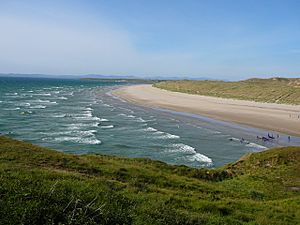
Golf
There are a number of golf courses such as Ballyliffin Golf Club, located in the Inishowen peninsula. Other courses of note are Murvagh (located outside Donegal Town) and Rosapenna (Sandy Hills) located in Downings (near Carrigart). The Glashedy Links has been ranked 6th in a recent ranking taken by Golf Digest on the best courses in Ireland. The old links was ranked 28th, Murvagh 36th and Sandy Hills 38th.
Cricket
Cricket is chiefly confined to The Laggan district and the Finn Valley in the east of the county. The town of Raphoe and the nearby village of St Johnston, both in The Laggan, are the traditional strongholds of cricket within the county. The game is mainly played and followed by members of the Ulster Protestants of Co. Donegal. St Johnston Cricket Club play in the North West Senior League, while Letterkenny Cricket Club play in the Derry Midweek League.
Athletics
Athletics has been one of the most successful sports in Donegal over the years with numerous athletes from County Donegal going on to represent Ireland at the international level, at least five winning medals at major events. Such athletes include Danny McDaid in the World Cross-Country Championships in 1979, Bridie Lynch who won medals in the World Paralympic Games in 1992 and 1996, Gary Murray who came 8th in the European Junior Cross-Country Championship of 1999, and Mark English who won medals in the European 800m Championships in 2014, 2015, 2018 and 2019. Sommer Lecky also achieved silver in the World Junior High Jump 2018. Other notable athletes from Donegal include Paul Dolan, Caitriona Jennings and Brendan Boyce each of whom has represented Ireland at the international level.
Other sports
Donegal's rugged landscape and coastline lends itself to active sports like climbing, mountain biking, hillwalking, surfing and kite-flying.
Education
Higher education within the county is provided by Letterkenny Institute of Technology (L.Y.I.T.; popularly known locally as 'the Regional'), established in the 1970s in Letterkenny. In addition, many young people from the county attend third-level institutions elsewhere in Ireland, especially in Derry and also at the Ulster University at Coleraine (U.U.C.), Ulster University at Jordanstown (U.U.J.), Queen's University Belfast ('Queen's'), and NUI Galway. Many Donegal students also attend the Limavady Campus of the North West Regional College (popularly known as Limavady Tech) and the Omagh College of Further Education of South West College (popularly known as Omagh Tech or Omagh College).
Images for kids
-
Doe Castle, home of the Sweeney clan
-
The Inishowen Peninsula as seen from the International Space Station
-
Aurora borealis (na Saighneáin) over Malin Head
-
Golden eagle (Aquila chrysaetos)
-
Snow atop Errigal
-
The Iron Age fortress Grianan of Aileach (Irish: Grianán Ailigh).
See also
 In Spanish: Condado de Donegal para niños
In Spanish: Condado de Donegal para niños


